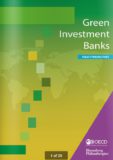
Bron
OECD
Investment is growing in renewable energy and energy efficiency, but not quickly enough to get the world on track to achieve zero net greenhouse gas emissions globally by the end of this century. Mobilising investment from the private sector will be essential to meet climate change goals. Governments can find ways to make efficient use of available public funding to mobilise much larger pools of private capital.
The OECD report “Green Investment Banks: Scaling up Private Investment in Low-carbon, Climate Resilient Infrastructure” aims to provide policy makers with the first comprehensive study of publicly capitalised green investment banks (GIBs), examining the rationales, mandates and financing activities of this relatively new category of public financial institution. It provides a non-prescriptive stock-taking of the diverse ways in which these public institutions are helping to leverage and catalyse private investment in domestic green infrastructure, with a spotlight on energy efficiency projects. Highlighting the role of GIBs within a broader policy framework to mobilise investment, the report also provides practical information to policy makers on how green investment banks are being set up, capitalised and staffed.
A GIB is a public entity established specifically to facilitate private investment into domestic low-carbon, climate-resilient (LCR) infrastructure. Using innovative transaction structures, risk-reduction and transaction-enabling techniques, and local and market expertise, GIBs are channelling private investment into low-carbon projects. GIBs are facilitating investment in such areas as commercial and residential energy efficiency retrofits, rooftop solar photovoltaic systems and municipal-level, energy-efficient street lighting.
PDF version
Many of the investments GIBs mobilise are undertaken in urban areas where 54% of the world’s population lived in 2014, and where 66% is projected to live by 2050.
Governments tailor their GIBs based on their unique national and local contexts. GIBs and GIB-like entities have diverse rationales and goals including meeting ambitious emissions targets, supporting local community development, lowering energy costs, developing green technology markets, creating jobs and lowering the cost of capital. Using a range of metrics, GIBs are measuring and tracking their performance. These metrics generally focus on emissions saved, job creation, leverage ratios (i.e. private investment mobilised per unit of GIB public spending), and – for those GIBs that are required to be profitable – rate of return.
GIBs are typically established in countries that do not have national development banks or other entities that are actively promoting private investment in domestic LCR infrastructure. They are relevant for both developed countries and emerging economies as a tool to help meet emissions, technology and infrastructure deployment and green investment targets. The creation of a GIB can send a signal to the marketplace and other countries that a country or region is seeking to become a leader in scaling up private low-carbon investments. To mount a serious effort to mobilise low-carbon investment and get on a path toward zero net emissions by the end of this century, governments need to consider how institutions like green investment banks can help them pick up the pace.





